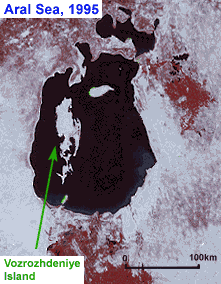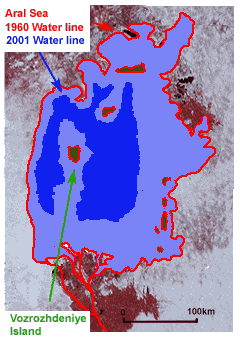Biological Weapons Waste Site Threatens to Spread Diseases in Aral Sea Region
June, 1999 Vozrozhdeniye Island, Uzbekistan
A stockpile of anthrax and other lethal bacteria, supposedly destroyed almost a decade ago, are resurfacing at at a Soviet-era biological weapons lab in the Aral Sea. Some of the bacteria are still viable, and they are be becoming more accessible, according to a June report in the New York Times. The stockpile is located at a decomissioned biological weapons laboratory on Vozrozhdeniye Island («Renaissance Island»), an island shared by the recently-independent states of Uzbekistan and Kazakhstan. Buried on the island are hundreds of tons of powdered anthrax bacteria, as well as plague, typhus, smallpox, and many other disease-causing organisms. Uzbekistan and Kazakhstan have sought US and Russian assistance in identifying and destroying the many toxic agents dumped there in 1988.

The bacteria were manufactured as part of the Soviet biological weapons program. The US manufactured similar toxins until 1972, when President Nixon signed a bill eliminating the US biological weapons program. Evidence recently gathered at the Vozrozhdeniye Island laboratory suggests that the Soviet Union maintained its bioweapons program until the 1980s. In 1988 stockpiled toxins were destroyed and sent to be buried at this remote island laboratory and testing site—at least officials thought they were destroyed.
Recent inspections by US biological weapons experts indicate that sludge from buried toxins is migrating toward the ground surface, and that some of the bacteria were not successfully destroyed before burial. As the materials seep toward the surface there is worry that Animals might carry them away from the site and toward populated areas. To make matters worse, the Aral Sea is shrinking, and the island is growing toward the shore (see map). For decades irrigation projects have diverted the rivers that supply this inland sea. The sea’s surface area has now shrunk to half its former size, and the volume of water is just a quarter what it was 30 years ago. As the water disappears, Vozrozhdeniye Island is expanding toward the shore, and the shore is growing toward the island. This makes the stockpiles accessible to people as well as to wandering Animals. Experts’ worst fear is that terrorists might soon be able to reach the island and its lethal waste repository by land.

Local and US experts are now attempting to decide how to destroy the lethal wastes, but decontaminating the island will be extremely expensive as well as logistically difficult.
To read more, see
Environmental Science, a Global Concern, Cunningham and Saigo, 5th ed.
Hazardous and toxic wastes: p. 525
Waste disposal: p. 517
Landfills: p. 518
Environmental Science, Enger and Smith, 6th ed.
Death of a Sea (essay on the Aral Sea): p. 316
Regulating hazardous materials: p. 386
mhhe home